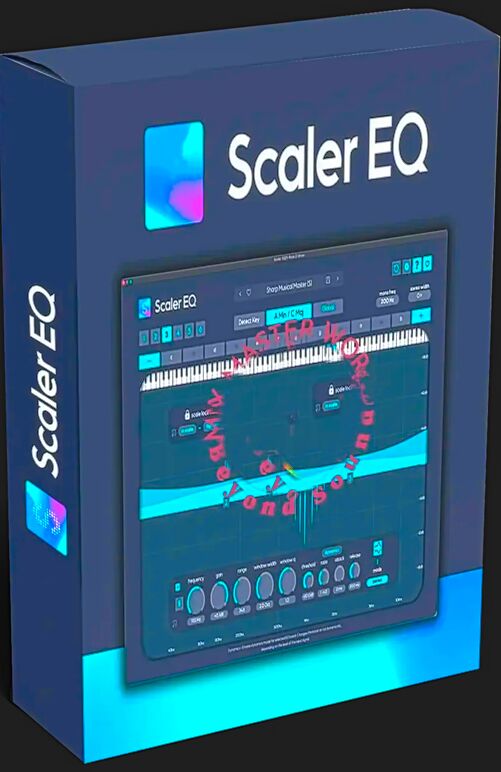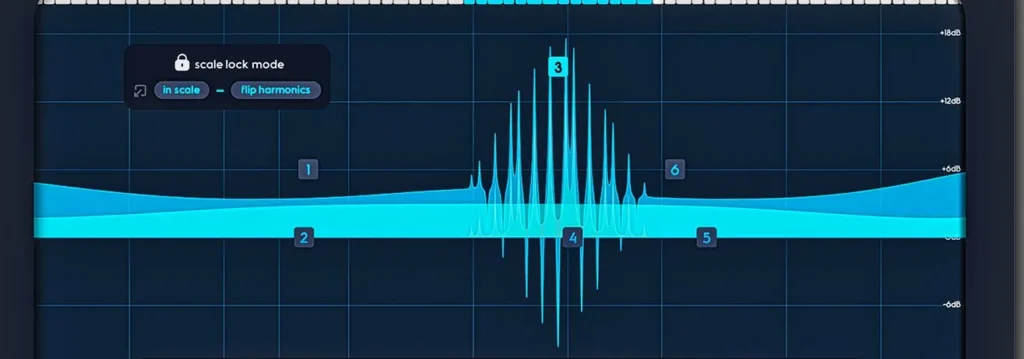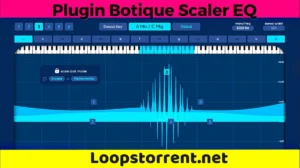Plugin Boutique Scaler EQ is a harmonic-based equalizer plugin. The EQ VST mainly affects frequencies that match the song’s key.
This plugin provides a different approach to the basic equalization operations, such as cuts and boosts, decreasing the problematic frequencies and other operations. The developers designed this plugin for music producers, mixing engineers, and mastering engineers.

This article will explore the following topics about this plugin in detail.
- Key Features.
- Detailed Overview.
- Uses and Applications.
- Technical Info and System Requirements.
- Comparison with Waves Q10 Equalizer.
- FAQs.
- Review.
- Conclusion.
So, without further ado, let’s get started.
Key Features:
- This plugin has smart EQ technology. This technology automatically detects the key of the input signal and applies the basic EQ settings according to the harmonic content and dynamic range.
- It also offers real-time visual feedback of the frequencies being cut down or boosted by this plugin. Thus, the user can see how the plugin shapes the frequencies.
- Its intelligent equalizing technology allows it to work on the single and grouped track. In other words, it also handles the complex mixes.
- It also automatically detects the song’s chords, which helps it match the EQ settings with the musical key.
- It also supports the MIDI integration for real-time manipulations.
- Scaler eq VST plugin also supports the mid-side processing. In this way, the user can independently apply eq to the mid and side frequencies to affect the stereo information of the input signal.
- There is also an option called Magic Shelf Band. This plugin feature makes the low-end punchier and delivers the smooth high-end.
- It also provides individual controls for each band, such as Threshold, Ratio, Attack and Release controls.
- Users can make each band of this eq plugin work on the mid, side, and stereo channels.
- It also consists of a wide range of presents that can serve as a starting point for the producers.
- The user interface of this plugin is also visually appealing and user-friendly. It is easy to navigate.
- It also suggests the EQ curves after analyzing the input signal. In this way, it points out the frequencies that should be reduced. This feature is also helpful for users who are new to EQ settings
Detailed Overview:
It is a very simple and easy-to-use plugin. I will explain it thoroughly in three sections: the preset manager, the visual feedback section, and the EQ controls.
Preset Browser:
The plugin’s top contains a preset browser. It includes different presets designed by professional producers.

This section also includes some other features. Below the preset manager are two buttons named detect key and global.
By pressing the button detect key, the plugin analyzes the audio and tries to detect the key and scale of the audio so that it can effectively affect the harmonics of the audio. The detected scale is also shown in the keyboard section of the plugin.
The second button is called global. By pressing the button, this plugin works as traditional eq means it does not detect the key and scale and works on the whole audio spectrum. Normally, when you click on different bands, the plugin will also select different keys, but by turning on the global option, the plugin will remain on your selected key and scale no matter what EQ band ( six EQ bands numbered from 1 to 6)
Next, we have two other controls: mono frequency and stereo width. Their function is clear from their names. By increasing the value of the stereo width control, the plugin will widen the signal and increase the stereo information of the input signal.
At the last, we have control names as mono frequency. The user can select a specific frequency, such as 200Hz, at these controls. Remember that If you choose a particular frequency, for example 200Hz, all the frequencies below 200 Hz will be in mono.
This control of the scaler eq helps the user handle the low end, which should be in mono in most cases.
Visual Feedback Section:
This VST shows the actual frequency behaviour in this section of the plugin. The plugin section also has different EQ bands from which to choose.
It provides a total of 6 bands to choose from.

1st and 6th bands are the high-shelf and low-shelf bands.
When the user selects the specific bands, a tab called scale lock mode appears on the plugin screen. This tab offers two options.
The first option lets the user select the functionality of the currently selected band. It lets the user boost the frequencies in the scale, which is set in the plugin, and also boost or cut down the frequencies that are not in the selected scale. By using both functions simultaneously, you can boost the in-key frequencies and cut the out-of-key ones.
The second option is called flip frequencies. By selecting this option ON, the plugin will flip the frequencies, meaning the low frequencies will become high, and the high frequencies will become low in real time.
Frequency controls of Scaler EQ:
Let’s move on to this plugin’s frequency control. A few frequency controls play a main role in designing the sound.

First of all, we have the frequency control knob. This is actually the range of the EQ plugin. Moving this knob will set the position of the EQ band.
The gain knob will set the amplitude of the band of EQs. With the help of this gain, the user can set the boost or cut up to ±24dB.
Dynamic Band Modes:
After the EQ control, we have the dynamic controls, which allow the user to adjust the frequencies of the input signal dynamically, as the compressor/ expander does.
Plus/Minus Filter:
Another feature that makes this plugin stand out is its plus-minus feature. This plus-minus filter enables the plugin to reduce the frequencies that are out of key and reduce the frequencies that are out of key within the same range.
Mid/Side Operation of Plugin Botique Scaler eq:
This EQ also allows the user to change the mid/side information of the input signal. This increases the stereo width of the sound and gives it a 3D feel.
Q Factor:
The Q factor adjusts the bandwidth of each frequency band. A higher value of this Q factor results in a narrower bandwidth, while a lower value broadens the range.
Uses and Applications
Mastering and Mixing:
EQ has always been essential for mixing and mastering. This EQ plugin offers advanced features like tweaking the harmonics and plus-minus filter simultaneously, so it is also an important need of mixing and mastering engineers.
Sound Design:
You can also use this plugin for sound design. The harmonic matching feature of this plugin is especially helpful for the user/sound designers who want to design or align a specific sound to a specific key. On the other hand, every EQ plugin plays a main role in sound design, with the help of high-cut and low-cut filters.
It helps the user add darkness or brightness to the sound and create an underwater effect. In short, this plugin also plays a vital role in sound design.
Key Detection:
This plugin can also be used for key detection, as there is a separate option dedicated to this feature. Now, key detection has major uses in the music industry. Once you have detected the key of a track, you can use it for remixing, vocal tuning if you want to make kakoree, and DJing.
But if you want to be an expert in your field, then you should train your ears for these tasks, but plugins like this are also a choice for these tasks.
Technical Info and System Requirements:
- Formats: VST, VST3, AU, AAX
- Bit depth: 64-bit
- Operating Systems: Windows 10 or later, macOS 10.13 or later
- CPU: Intel Core i5 or equivalent (i7 recommended)
- RAM: 8 GB minimum (16 GB recommended)
- Storage: 500 MB free hard disk space
- Internet connection required for product activation
Comparison with the Waves Q 10 Plugin:
| Features | Waves Q 10 | Plugin Boutique Scaler EQ |
| Developers | This plugin is developed by the Waves company. | This one is developed by the Plugin Boutique |
| Type | This is parametric EQ. It is a classic EQ plugin. | This one is a modern EQ plugin with advanced features. |
| Bands | It provides 10 bands | It provides only 6 bands. |
| Special Features | It does not have any special features except good sound quality. | Besides the EQ plugin, it provides the compressor/ expander. It also provides special features like EQ matching, harmonics manipulations, plus-minus filer and much more. |
| Interface | It interface is user-friendly and classic. It is easy to navigate. It does the frequency spectrum visuals in real time | Its interface is modern and user-friendly. It provides frequency spectrum visuals in real-time. |
| Compatibility | Windows and macOS, VST, AU, AAX | Windows and macOS, VST, AU, AAX |
| CPU Usage | Low | Moderate |
| Popularity | It is already popular in the industry due to its sound quality | It is newly released plugin. It could be popular due to its advanced features. |
| Learning Curve | It is easy | It is bit complex due to advanced features |
| Target Audience | Music producers, sound engineers, mixing and mastering engineers | Music producers, sound engineers, mixing and mastering engineers and also suitable for the creative people. |
| Low Latency | Yes | Yes |
| EQ Matching | It does not have the EQ matching feature. | It does not have the EQ matching feature. |
FAQs
Can Plugin Boutique Scaler EQ be used in live performances?
Yes, this plugin can also be used for live performances, as it provides a low-latency mode and integrates with the MIDI controllers that are important for live performances.
What are features of the Scaler EQ which make it unique from the other EQ plugins?
Here are the features that make it unique from the other EQ plugins.
- Automatic Key detection.
- Automatic Scale detection.
- Harmonic-based Controls.
- Plus, there is a Minus filter that cuts and boosts frequencies out of and in the key, respectively.
- EQ matching feature.
Review:
This review reflects my personal opinion and experience with the plugin. I have purchased the plugin myself and have no affiliation with the company. I have not received any compensation or free products for this review. My opinions are entirely my own, and they may differ from yours. The content of this review is intended to provide information and assistance to potential users.
I used this plugin and here is my honest review in the form of pros and cons.
First of all, let me list the pros of this plugin.
Pros:
- This plugin provides great control over the harmonics. By affecting the harmonics, the tonality of the sound can be changed. This can be very useful for mixing and mastering and also for sound design.
- It also provides a user-friendly interface that is easy to navigate and provides real-time visual feedback on the frequency spectrum. In this way, the user can realize what the plugin does to the sounds and what areas of the input signal have resonant frequencies.
- It automatically detects the song’s key and scale and suggests EQ curves after analyzing the audio signal. This could be a great starting point for users who are new to this field. On the other hand, professional users can also use these features as suggestions.
- Its magic shelf band, mid-side processing, etc, are good features to increase workflow.
Cons:
- Although this plugin is user-friendly, it offers some advanced features, such as harmonics-based EQ, magic shelf, etc., which could be a bit confusing for beginners.
- This plugin offers only 6 bands, which might be limited for users who work with multiple bands.
- The low latency mode is available for live performances, but it is not well optimized, which is also a drawback.
Conclusion:
- Plugin Boutique Scaler EQ is a harmonic EQ plugin.
- It provides advanced features like auto EQ suggestions, increasing and decreasing the frequencies in and out of key, key and scale detection, etc.
- It can be used for mixing, mastering, sound design, etc.
- It could be a bit consuming for beginners due to its advancements.
- The interface of this plugin is also user-friendly, it provides 6 EQ bands.
